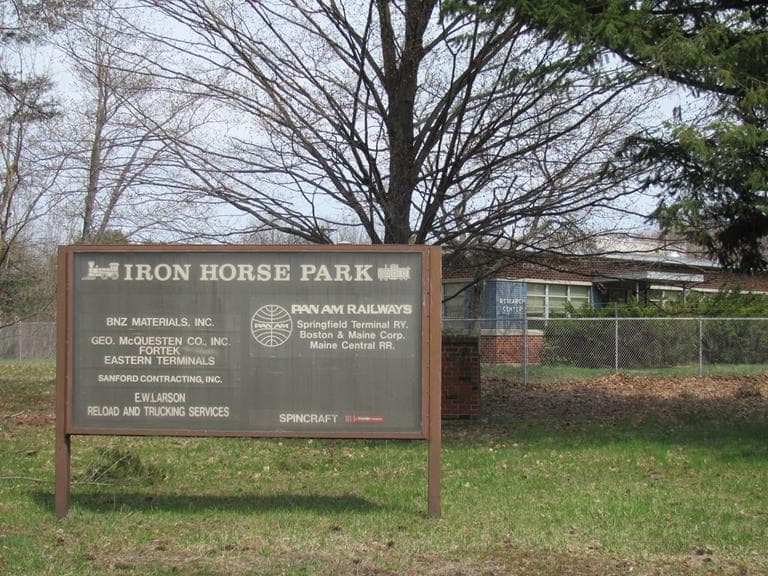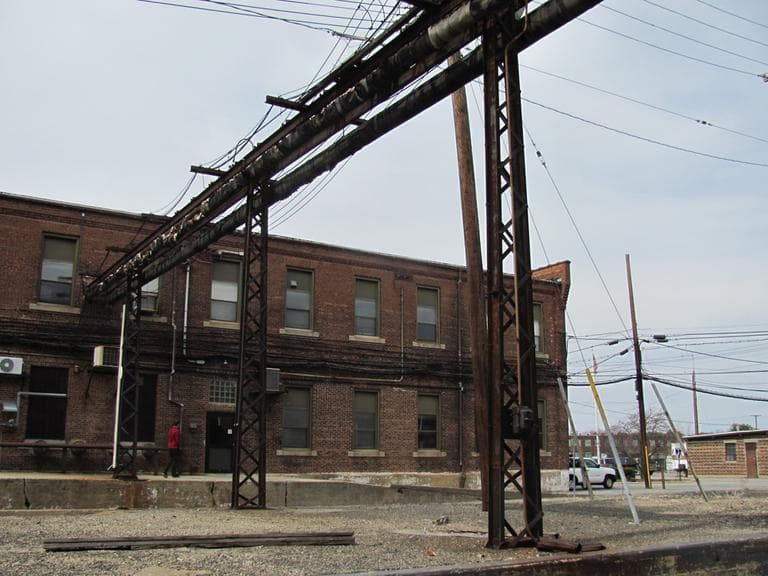Advertisement
The Ugly Truth: Mass. Superfund Sites Still Toxic Nearly 30 Years And More Than $1B Later
Resume[asset]2011/wbur_0522_superfund/[/asset]
In all his years as an attorney, Jan Schlichtmann has had few lawsuits so profoundly affect him as a 1982 case involving eight Woburn families and a public water supply contaminated by toxic chemicals. Profiled in numerous newspaper, television and radio accounts along with the movie “A Civil Action” starring John Travolta, the lawsuit became a watershed event in environmental politics for Massachusetts and the nation.
Yet today, nearly 30 years after that landmark court case, the wells that supplied both toxic drinking water and a legacy of cancer to Woburn remain contaminated despite a $21 million cleanup effort. And no one, not even the U.S. Environmental Protection Agency which monitors the site as part of the federal Superfund program, knows whether humans are still being exposed to its witch's brew of chemicals, federal records show.
“Woburn made people see the profound health effects that can occur from contaminated sites,” says Schlichtmann, who settled the 1982 case for $8 million. “The ugly truth is that the damage we do today will take a long time to fix.”
Woburn isn't alone when it comes to facing “the ugly truth” hidden in its soil and water. Twenty five other Bay State communities, all home to Superfund sites, still live with a toxic legacy despite millions of dollars spent to clean them up.

From Cape Cod to the Berkshires and beyond, few communities are left untouched by the contamination. With between 3,000 and 5,000 polluted sites currently listed with the Massachusetts Department of Environmental Protection and 40,000 others already cleaned up by that agency since 1985, the state remains a patchwork of toxicity.
"They're everywhere,” Eugene Benson, legal counsel and program director for Alternatives for Community and Environment, said of the many contaminated sites that dot the Massachusetts landscape. “They range from sites that aren't serious to sites that are very serious. Some of the worst and most extensive sites are on the Superfund list," he notes, "but there still are some very bad sites, as far as contamination and the toxins, that are not on the Superfund list too."
Benson, whose organization works to achieve environmental justice for low income communities and communities of color, said DEP's website offers a way for residents to check out toxic waste sites in their own community.
The worst of those sites, the ones that pose an imminent health risk, rise to federal Superfund status, however.
In Massachusetts, 31 sites have attained that ranking. According to EPA records, at least one-third of those sites may pose a health risk to people living and working nearby. At five of those locations, the risk of human exposure is noted in EPA cleanup impact profiles, all compiled since 2010.
At some sites like New Bedford Harbor where PCB-contaminated seafood is a concern, the exposure risk is listed as "not under control,” meaning that human contact with pollutants is possible. At other sites, such as the Industri-Plex site in Woburn where cleanup is estimated to run up to $13.6 million, contaminated groundwater continues to migrate to other areas, according to those same reports. At six other state hot spots, there is insufficient data to determine the status of groundwater migration or human exposure to toxins, the EPA cleanup impact profiles found.
Avoiding exposure is even more difficult at some toxic properties because there are no signs posted to warn of the contamination. Others, like Iron Horse Park in Billerica, are still open for business even though the EPA lists that location as one where human exposure is not yet under control.
In towns like Wilmington, where toxic waste discovered in 1980 still hasn't been fully cleaned up, residents worry that a spike in cancer clusters is caused by the poisonous brew found in the wells they were drinking from until the town closed them in 2002. The EPA, which added the 53-acre former chemical plant in Wilmington to its Superfund list in 2006, is only now conducting studies.
Even parcels that have been on the list the longest, like the Baird and McGuire chemical plant in Holbrook, ranked as the 14th worst site in the nation when it was added to the Superfund roster in 1982, continue to be tainted. Despite a cleanup effort estimated by the EPA to top more than $220 million, a groundwater study conducted last year under that federal agency's authorization found metals such as arsenic still remain in high concentrations on that site 30 years later.

Yet it's not just chemical companies that are running up the toxic tab. In a state where cleanup costs for commercial sites are estimated by the EPA to stretch beyond $1 billion, the biggest polluter may very well be the federal government.
With six military facilities on the Superfund list, the federal government also is linked to at least six other contaminated sites in Palmer, Lowell, Attleboro, Concord, Tyngsborough, and Bridgewater, according to confidential EPA records of the top 100 "potentially responsible parties" obtained by the Center for Public Integrity.
W.R. Grace ranks second with ties to seven sites in Woburn, Dartmouth, Acton, Lowell, Billerica, Bridgewater, and Tyngsborough, those same records show.
The cost of cleaning up all those toxic minefields remains unclear. EPA says the “potential responsible parties” who often pay for the cleanup are not required to release cost figures. Neither the EPA nor Department of Defense officials were able to produce cleanup figures for any of the six military facilities in Massachusetts.
As toxic waste continues to percolate in groundwater and remediation costs soar into the stratosphere, it all seems like bad news to enviro-conscious activists like Taryn Hallweaver, the Eastern Massachusetts community organizer for the Toxics Action Center, a New England-based advocacy group.
“We've got an industrial legacy like nowhere else in the country,” she says of the state's toxic history, which stretches back to the 1800s and the Industrial Revolution. “It's become a serious issue for Massachusetts. These sites just aren't getting cleaned up.”
A generation has already passed since the Woburn site and three others in Massachusetts landed on the EPA's list of the 114 most contaminated spots in America. Created in 1980 in response to health concerns over toxic waste in neighborhoods like New York's Love Canal, Superfund, — formally known as the Comprehensive Environmental Response, Compensation and Liability Act – is today comprised of more than 1,300 toxic hot spots nationally.
In Massachusetts, the four sites that made it onto the nation's first Superfund list are still on it. Sixteen others, all added during the 1980s, remain on that list as well despite more than $500 million already invested in their cleanup. A quarter of those 20 locations – New Bedford Harbor, Fort Devens, Iron Horse Park in Billerica, and Woburn's Industri-Plex site – still show signs of contamination nearly three decades after first being identified.
In western Massachusetts, where PCS Resources, a waste oil refinery and solvent recovery plant in Palmer earned Superfund designation in 1983, contaminated soils have been removed and cleanup levels achieved but in 2010, an EPA study of the site found that 1,4-dioxane, a contaminant not previously assessed, may be present on that property.
Part of the reason behind the snail's pace of cleanup is due to the lack of technology to quickly remove toxins from soil and groundwater. Cleaning up ground and water contamination is an arduous and cumbersome task that may take decades to complete, officials maintain. Site owners also force lengthy delays, challenging EPA decisions and balking at the cost of cleanup, creating a lull that can sometimes last for years. Yet, despite all the wrangling, EPA says it routinely collects 70 percent of all cleanup costs from the businesses that caused the contamination.
In 2002, however, the agency faced perhaps its biggest challenge of all when Congress slashed the Superfund's primary income source - a tax targeting industrial polluters that once generated about $1 billion annually. By the end of Fiscal 2003, the fund's balance was zero, down from a peak of $3.8 billion in 1996. Today, appropriations are made by Congress, which last month proposed cutting $23 million from the Superfund budget in a cutback that would slash it from $1.31 billion to $1.28 billion for the rest of the fiscal year.
Enforcement actions by the EPA supplement that budget, with responsible businesses paying for cleanup costs often under court ordered agreements, EPA officials say.
Still, the budget cuts have taken a toll. A precipitous scale-down of cleanup activity has cut mitigation by more than 50 percent, notes Ed Hopkins, the director of environmental quality for the Washington, DC-based Sierra Club.
“During the Clinton administration, roughly 80 sites were getting cleaned up every year" nationally, he says. “In the last eight or nine years, that rate has fallen by half and more recently, it’s been even lower.”
Yet despite that decline, state and federal officials – and even some environmentalists– are optimistic about our toxic fate.
Toughened federal regulations and more public vigilance have helped curtail the creation of new Superfund sites, says Robert Cianciarulo, chief of the Massachusetts Superfund Section for EPA. In fact, he notes, the last time a site was added to the Bay State's Superfund list was in 2006. Only three sites have made that list in the last 10 years, he adds.
“Our practices have really changed in that we're not creating new Superfund sites the way we have historically,” says Jo Anne Shatkin, CEO of CLF Ventures, the non-profit consulting arm of the Conservation Law Foundation. “Despite the fact that we have so many sites here and so many sites that still need to be cleaned up, we have made progress.”
Still, some worry that further budget cuts could take the sting out of the state and federal agencies that serve as environmental watchdogs, slowing down mitigation efforts even further.
“If EPA doesn't have the resources to investigate problems and enforce the law, it takes away the incentive for industries to clean up their own problems,” notes Hopkins. “We need to have a dedicated source of funding to get this job done in a timely way.”
Even Schlichtman agrees with that.
“We don't have another 50 years to clean up the messes we are creating now,” he says. “We have to take action to prevent this large scale pollution or we're not going to be around at the end of the century."
More:
This program aired on May 22, 2011.